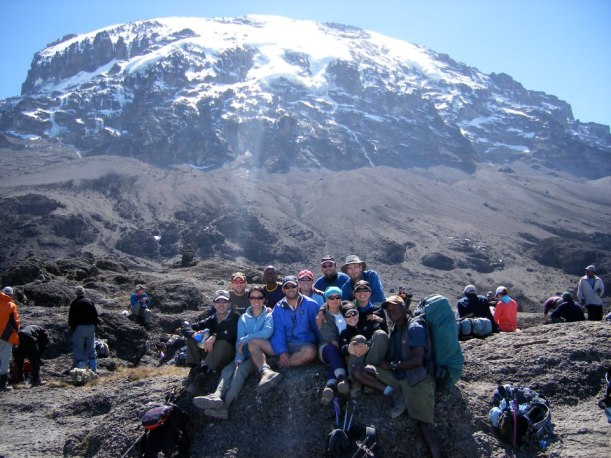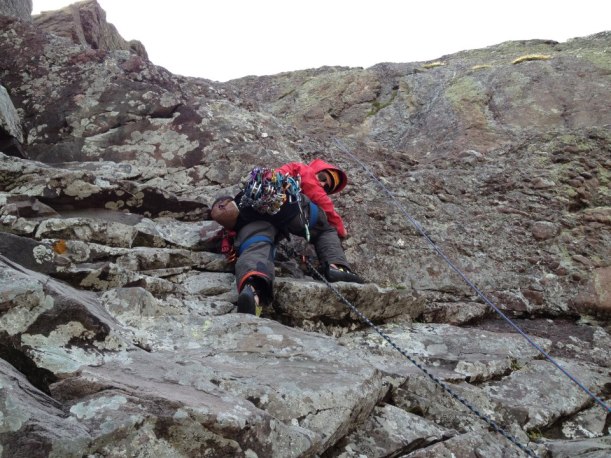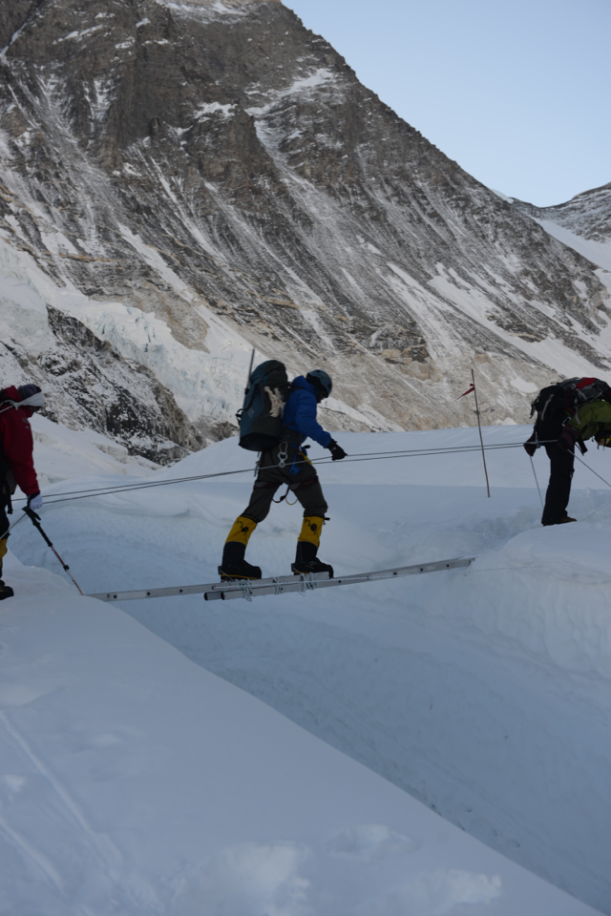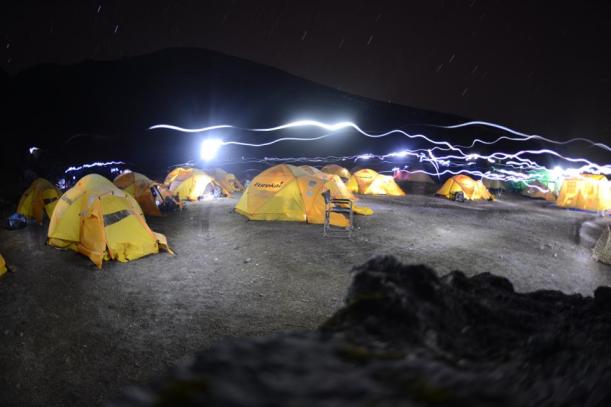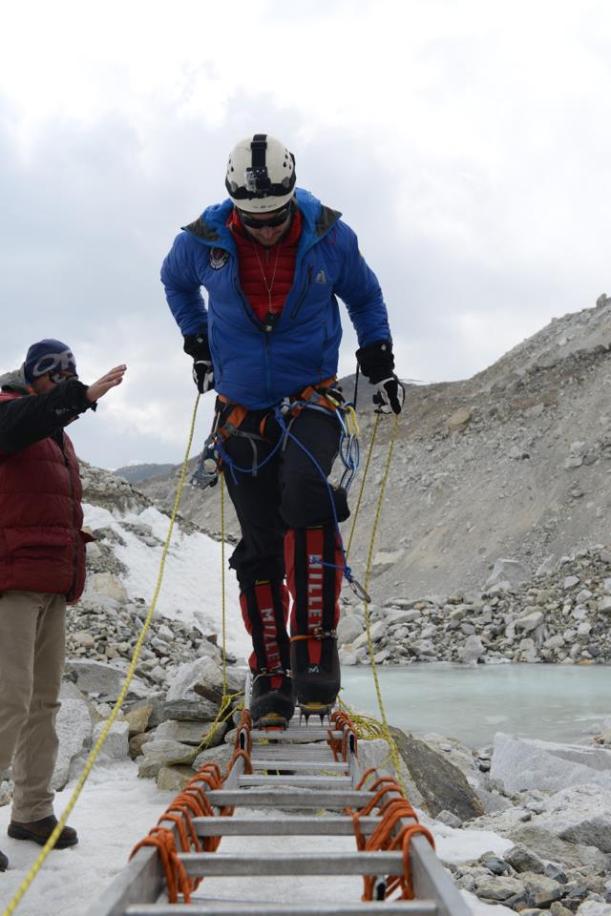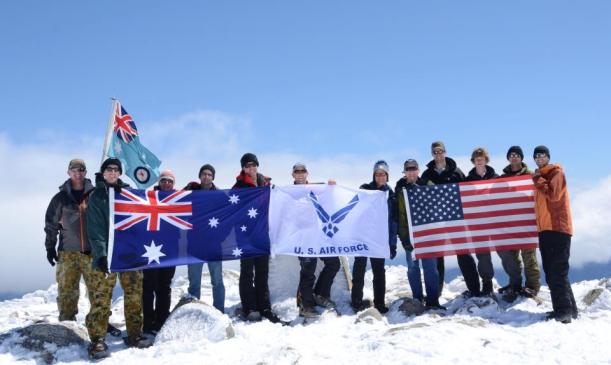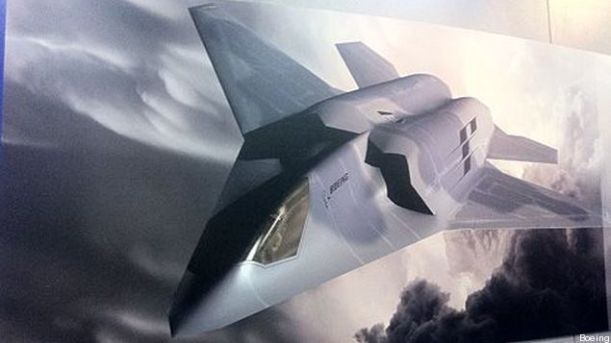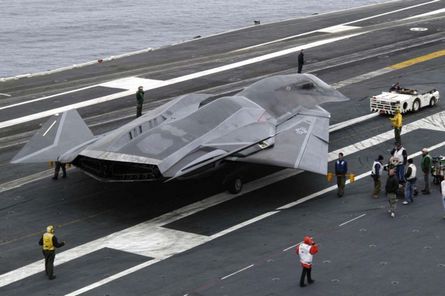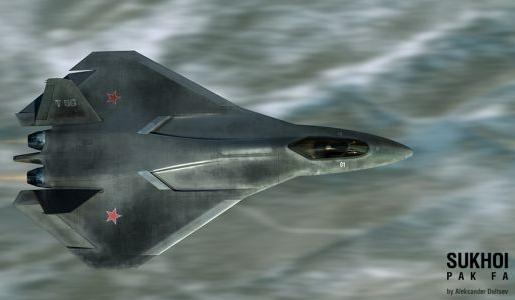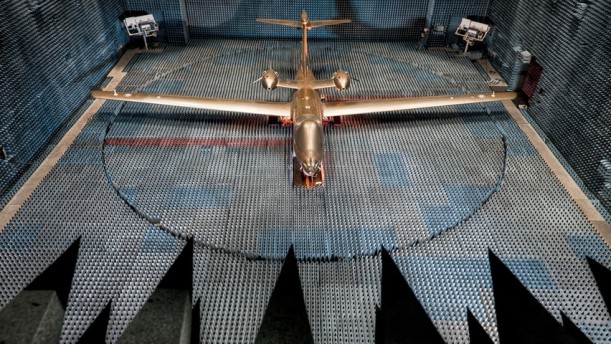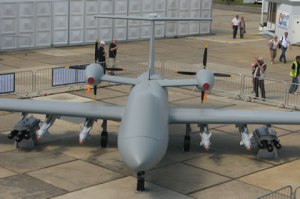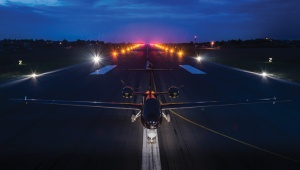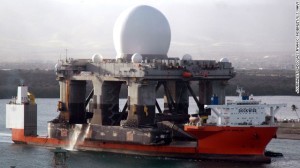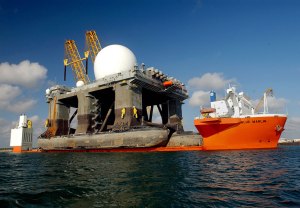
English: With smoke from the Lake Arrowhead area fires streaming in the background, NASA’s Ikhana unmanned aircraft heads out on a Southern California wildfires imaging mission. (Photo credit: Wikipedia)
SAR Baseline (Production Estimate)
FY 2011 President’s Budget dated February 1, 2010
Approved APB
Defense Acquisition Authority (DAE) Approved Acquisition Program Baseline (APB) dated February 12, 2012 MQ-9 UAS REAPER December 31, 2011 SAR
Mission and Description
Mission:
The MQ-9 Unmanned Aircraft System (UAS) Reaper is a multi-mission Hunter-Killer and Intelligence, Surveillance and Reconnaissance (ISR) system, which provides the combat commander with a persistent capability to find, fix, track, target, engage and assess Time Sensitive Targets. In the Hunter-Killer mission, the M-Q 9 offers the commander a choice of weapons including the Hellfire Air-to-Ground Missile, Laser Guided Bombs and Joint Direct Attack Munitions. In the ISR role, the MQ-9’s ability to fly for up to 14 hours at altitudes up to 25,000-30,000 feet while carrying up to 3,000 pounds on the wings make it the platform of choice for a number of ISR and strike missions. This ability to support a wide variety of operations results in a steady stream of requirements to develop new capabilities to support an expanding array of missions. As a result of the combat deployment of the developmental system, the MQ-9 is supported and maintained by contractor logistics support personnel under contract and managed by the MQ-9 Program Office (PO).
Description:
An MQ-9 system consists of four aircraft, a Ground Control Station (GCS), a Satellite Communications terminal, support equipment, maintenance and operations personnel deployed for 24-hour operations. The aircraft is controlled by a pilot who is located in the GCS. Control commands are transmitted from the GCS to the aircraft by a ground based datalink terminal. The GCS incorporates workstations that allow operators to plan missions, control and monitor the aircraft, reconnaissance sensors and weapons and exploit received images. The MQ-9 carries the Multi-spectral Targeting System which integrates electro-optical, infrared, laser designator, and laser illuminator into a single sensor package. The system is composed of four major components which can be deployed for worldwide operations. The MQ-9 aircraft can be disassembled and loaded into a container for travel. The GCS is transportable in a C-130 Hercules (or larger) transport aircraft or installed in a fixed facility. The MQ-9 can operate on a 5,000 by 75 feet (1,524 meters by 23 meters), hard surface runway with clear line-of-sight. The ground data terminal antenna provides line-of-sight communications for takeoff and landing. The satellite communication system provides over-thehorizon control of the aircraft. An alternate method of employment, Remote Split Operations, employs a mobile version of the ground control system for launch and recovery efforts. This system conducts takeoff and landing operations at the forward deployed location while the Continental United States based GCS conducts the mission via extended communication links.
In March 2006, COMACC (Commander of Air Combat Command) directed early fielding to meet operational needs. To meet the early fielding date, the program was broken into two blocks with Block 1 providing initial capability to meet the early fielding date and Block 5 completing the program to the Increment I requirements as described in the Capability Production Document (CPD). Consequently, the MQ-9 Increment I program is comprised of Block 1 and Block 5 aircraft. This SAR only includes Increment I requirements. An Increment II subprogram will be established in the future to incorporate additional capabilities into the MQ-9 Weapon System. Increment II has a separate Capability Development Document and will have a separate CPD.
The MQ-9’s combat potential and demonstrated combat performance fueled the rapid growth of the program. By January 2012, the Air Force contracted for a total of 157 MQ-9s which included 58 added by Congress to accelerate fielding in support of the overseas contingency operations. As of February 29, 2012, General Atomics-Aeronautical Systems Inc. (GA-ASI) delivered 93 of the 404 planned aircraft, 53 of which are operationally active. While the MQ-9 program was initially managed as a Quick Reaction Capability program, a separate program office was established in 2006 to restructure the program to support Air Combat Command’s urgent request to field the system. The MQ-9 has been actively flying combat missions in overseas contingency operations since September 2007.
The program is in concurrent capability development, procurement, combat operations and support. This situation resulted from the MQ-9’s urgent beginnings in the weeks after September 11, 2001, its growth as a Hunter-Killer to support overseas contingency operations, and the MQ-9’s evolution into the platform of choice for both Intelligence Surveillance and Reconnaissance (ISR) and Hunter-Killer missions.
MQ-9 UAS REAPER December 31, 2011 SAR

CBP Air and Marine group conduct aerial operations with their UAS aircraft over areas affected by Hurricane Ike to help broadly assess damage so as to better deploy rescuers to specific areas with the most need. (Photo credit: Wikipedia)
Executive Summary
Air Combat Command (ACC) stood up six additional MQ-9 Combat Air Patrols (CAPs) since the last SAR, bringing the total number to 22. This brings the total number of combined MQ-1 Unmanned Aircraft System (UAS) Predator and MQ-9 CAPs serving US and Allied warfighters to 57. These CAPs enabled the MQ-9 to accumulate 242,560 cumulative flight hours. The Program Office (PO) remains on track to support the Air Force required fielding of the required 65 CAPs (MQ-1 and MQ-9) by 3Q FY 2014.
Since the last SAR, the MQ-9, along with the MQ-1, achieved the requirement to provide 50 CAPs. This was completed on April 2, 2011, nearly six months ahead of schedule. The PO is on schedule to meet the June 2012 Required Assets Available (RAA) date with only one remaining item; Block 1 integration of electronic technical manuals. The decision was made to postpone the Milestone C from June 2011 to June 2012 to allow additional time to revise the test strategy; conduct first flight of a modified Block 1 aircraft with 904.6 Rev A software, and complete the required Milestone C program documentation. The first modified Block 1 aircraft was delivered to Gray Butte, CA on January 11, 2012, approximately six months ahead of schedule. Ground testing is in progress.
On February 12, 2012 the PO received the signed Acquisition Program Baseline (APB).
The PO initiated a Business Case Analysis (BCA) in November 2009 for the purpose of determining the “best value” long term sustainment strategy. The expected outcome of the BCA is a Performance Based Logistics approach which embraces public and private partnership arrangements. The BCA schedule was accelerated and the final report is due in June 2012 with coordination to follow.
There are no significant software-related issues with this program at this time.
MQ-9 UAS REAPER December 31, 2011 SAR
Threshold Breaches
APB Breaches
Schedule
Performance
Cost RDT&E
Procurement
MILCON
Acq O&M
Unit Cost PAUC
APUC
Nunn-McCurdy Breaches
Current UCR Baseline
| PAUC |
None |
| APUCOriginal UCR Baseline |
None |
| PAUC |
None |
| APUC |
None |
MQ-9 UAS REAPER December 31, 2011 SAR
Schedule
)
| Milestones |
SAR Baseline Prod Est
|
Current APB
Production
Objective/Threshold
|
Current Estimate
|
| Milestone B ACAT II |
FEB 2004 |
FEB 2004 |
FEB 2004 |
FEB 2004 |
| Milestone C ACAT II Block 1 |
FEB 2008 |
FEB 2008 |
FEB 2008 |
FEB 2008 |
| IOT&E for Block 1 |
MAY 2008 |
MAY 2008 |
MAY 2008 |
MAY 2008 |
| RAA |
SEP 2010 |
DEC 2011 |
JUN 2012 |
JUN 2012 |
| Milestone C ACAT ID Increment 1, Block 5 |
MAR 2011 |
JUN 2012 |
MAY 2013 |
JUN 2012 |
| FOT&E for Increment I Block 5 |
NOV 2012 |
NOV 2013 |
OCT 2014 |
NOV 2013 |
| FRP Decision for Increment I Block 1 and 5 |
MAR 2013 |
JUL 2014 |
JUN 2015 |
JUL 2014 |
Acronyms And Abbreviations
ACAT – Acquisition Category
FOT&E – Follow-On Test and Evaluation
FRP – Full Rate Production
IOT&E – Initial Operational Test and Evaluation RAA – Required Assets Available
Change Explanations
(Ch-1) The current estimates for RAA and Milestone C ACAT ID Inc 1, Block 5, changed from Jul 2011 to Jun 2012 due to timelines required to complete Milestone C documentation, testing associated with Block 5 capabilities, and reliability metrics/growth program improvements. Due to the delay in Milestone C, FOT&E for Increment I Block 5 changed from Apr 2013 to Nov 2013 and FRP Decision for Increment I Block 1 and 5 changed from Sep 2013 to Jul 2014.
Memo
RAA includes two fixed Ground Control Stations (GCS), two mobile GCSs, six Primary Mission Aircraft Inventory MQ-9 UAS REAPER December 31, 2011 SAR
(PMAI) Block 1 aircraft, technical orders, support equipment, initial and readiness spares packages, and logistics support.
MQ-9 UAS REAPER December 31, 2011 SAR
Performance
| Characteristics |
SAR Baseline Prod Est
|
Current APB
Production
Objective/Threshold
|
Demonstrated Performance
|
Current Estimate
|
| Hunter |
The system’s capability must allow a targeting solution at the weapon’s maximum range. |
The system’s capability must allow a targeting solution at a direct attack weapon’s maximum range |
The system’s capability must allow a targeting solution at a direct attack weapon’s maximum range |
DT ongoing for KPP;AFOTEC
IOT&E did not evaluate KPP due to system
availability;
Full KPP evaluation deferred to future
FOT&E |
The system’s capability must allow a targeting solution at the weapon’s maximum range. |
| Killer |
System must be capable of computing a weapon’s release point, passing required information, at the required accuracy, to the weapon and reliably releasing the weapon upon command. |
System must be capable of computing a weapon’s release point, passing required information, at the required accuracy, to the weapon and reliably releasing the weapon upon command. |
System must be capable of computing a weapon’s release point, passing required information, at the required accuracy, to the weapon and reliably releasing the weapon upon command. |
AFOTECIOT&E found KPP
operationally effective and suitable |
System must be capable of computing a weapon’s release point, passing required information, at the required accuracy, to the weapon and reliably releasing the weapon upon command. |
| Net Ready: The system must support Net-Centric military operations. The system must be able to enter and be managed in the network, and exchange data in a secure manner to enhance mission effectiveness. The system must continuously provide survivable,interoperable, secure, |
The Systemmust fully support
execution of
all
operational activities identified in the applicable joint and system integrated architectures and the system must |
The Systemmust fully support
execution of
all
operational activities identified in the applicable joint and system integrated architectures and the system must |
The Systemmust fully support execution of joint critical operational activities identified in the applicable joint and system integrated architectures and the system must |
JITCcertified
KPP; JITC
certification is renewed for each software update |
The Systemmust fully support execution of all operational activities identified in the applicable joint and system integrated architectures and the system must |
MQ-9 UAS REAPER December 31, 2011 SAR
| and operationally effective information exchanges to enable a Net-Centric military capability. |
satisfy the technical requirements for NetCentric military operationsto include 1)
DISR mandated
GIG IT standards and profiles identified in
the TV-1, 2)
DISR mandated GIG KIPs
identified in the KIP declaration table, 3)
NCOW-RM
Enterprise
Services 4)
IA requirements including availability, integrity, authentication, confidentiality, and nonrepudiation, and issuance of an ATO by the DAA, and 5) Operationally effective information exchanges; and mission
critical
performance and information
assurance
attributes, data correctness, data |
satisfy the technical requirements for NetCentric military operationsto include 1)
DISR mandated
GIG IT standards and profiles identified in
the TV-1, 2)
DISR mandated GIG KIPs
identified in the KIP declaration table, 3)
NCOW-RM
Enterprise
Services 4)
IA requirements including availability, integrity, authentication, confidentiality, and nonrepudiation, and issuance of an ATO by the DAA, and 5) Operationally effective information exchanges; and mission
critical
performance and IA
attributes, data correctness, data
availability, and |
satisfy the technicalrequirements for transition to NetCentric military operations
to include 1)
DISR mandated
GIG IT standards and profiles identified in
the TV-1, 2)
DISR mandated GIG KIPs
identified in the KIP declaration table, 3)
NCOW-RM
Enterprise
Services 4)
IA requirements including availability, integrity, authentication, confidentiality, and nonrepudiation, and issuance of an IATO by the DAA, and 5) Operationally effective information exchanges; and mission
critical
performance and IA
attributes, data correctness, data
availability, |
|
satisfy the technical requirements for Net-Centric military operationsto include 1)
DISR mandated
GIG IT standards and profiles identified in
the TV-1, 2)
DISR mandated GIG KIPs
identified in the KIP declaration table, 3)
NCOW-RM
Enterprise
Services 4)
IA requirements including availability, integrity, authentication,
confiden-
tiality, and nonrepudiation, and issuanceof an ATO by the DAA, and 5) Operationally effective information exchanges; and mission
critical
performance and information
assurance
attributes, data correctness, data |
MQ-9 UAS REAPER December 31, 2011 SAR
|
availability, and consistent data processing specified in the applicable joint and system integrated architecture views. |
consistent data processing specified in the applicable joint and system integrated architecture views. |
and consistent data processing specified in the applicable joint and system integrated architecture views. |
|
availability, and consistent data processing specified in the applicable joint and system integrated architecture views. |
Requirements Source:
Air Force Requirements for Operational Capabilities Council (AFROCC) Capability Production Document (CPD), dated August 8, 2006, validated by Joint Requirements Oversight Council (JROC) on January 29,2007. AFROC Memo 07-11-01 dated July 21, 2011.
Acronyms And Abbreviations
AFOTEC – Air Force Operational Test and Evaluation Center
ATO – Approval to Operate
DAA – Designated Approval Authority
DISR – Department of Defense Information Technology Standards Registry
DT – Developmental Testing
FOT&E – Follow-On Operational Test and Evaluation
GIG – Global Information Grid
IA – Information Assurance
IATO – Interim Approval to Operate
IOT&E – Initial Operational Test and Evaluation
IT – Information Technology
JITC – Joint Interoperability Test Command
KIP – Key Interface Profile
KPP – Key Performance Parameter
NCOW-RM – Net-Centric Operations and Warfare Reference Model TV-1 – Technical Standards Profile
Change Explanations
None
MQ-9 UAS REAPER December 31, 2011 SAR
Track To Budget

English: An MQ-9 Reaper takes off on a mission in Afghanistan Oct. 1. (Photo credit: Wikipedia)
General Memo
RDT&E Program Element (PE) 0305205F was shared by the MQ-1 Predator, MQ-9 Reaper and Global Hawk program offices from FY 2002 – FY 2004.
RDT&E PE 0305219F were shared by the MQ-1 Predator and MQ-9 Reaper program office from FY 2005 – FY 2007.
Procurement ICN’s PRDTA1 and PRDT01 were shared by the MQ-1 Predator and MQ-9 Reaper program office from FY 2002 – FY 2007.
| RDT&E |
|
|
|
|
| APPN 3600
|
BA 07 |
PE 0205219F |
(Air Force) |
|
| |
Project 5246 |
MQ-9 Development andFielding |
(Shared) |
|
| APPN 3600 |
BA 07 |
PE 0305205F |
(Air Force) |
|
| |
Project 4755 |
|
(Shared) |
(Sunk) |
| APPN 3600 |
BA 07 |
PE 0305219F |
(Air Force) |
|
| |
Project 5143 |
|
(Shared) |
(Sunk) |
| Procurement |
|
|
|
|
| APPN 3010 |
BA 07 |
PE 0205219F |
(Air Force) |
|
| |
ICN 000075 |
Organic Depot Activation |
(Shared) |
|
| APPN 3010 |
BA 06 |
PE 0205219F |
(Air Force) |
|
| |
ICN 000999 |
Initial Spares |
(Shared) |
|
| APPN 3010 |
BA 05 |
PE 0305205F |
(Air Force) |
|
| |
ICN PRDT01 |
Aircraft Modification |
(Shared) |
(Sunk) |
| APPN 3010 |
BA 04 |
PE 0305205F |
(Air Force) |
|
| |
ICN PRDTA1 |
Aircraft Procurement |
(Shared) |
(Sunk) |
| APPN 3010 |
BA 04 |
PE 0205219F |
(Air Force) |
|
| MQ-9 UAS REAPER |
|
|
|
December 31, 2011 SAR |
|
|
| |
ICN PRDTB1 |
Aircraft Procurement |
|
|
|
| APPN 3010 |
BA 05 |
PE 0205219F |
(Air Force) |
|
|
| MILCON
|
ICN PRDTB2 |
Aircraft Modification |
|
|
|
| APPN 3300 |
BA 01 |
PE 0205219F |
(Air Force) |
|
|
|
Project BHD000 |
MQ-9 Operations |
|
|
|
MQ-9 UAS REAPER December 31, 2011 SAR
Cost and Funding
Cost Summary
|
TY $M |
|
SAR
Baseline
Prod Est
|
Current
APB
Production
Objective |
Current Estimate
|
Total Acquisition Cost and Quantity
RDT&E 778.8 1005.7 1106.3 1004.1 809.9 1063.2 1063.2
|
8038.7
|
— |
— |
7905.7 |
8943.4 |
— |
9059.0 |
|
8038.7
|
— |
— |
7905.7 |
8943.4 |
— |
9059.0 |
|
0.0
|
— |
— |
0.0 |
0.0 |
— |
0.0
|
|
1785.3
|
— |
— |
2493.2 |
1922.6 |
— |
2812.3 |
|
1109.0
|
— |
— |
997.0 |
1202.4 |
— |
1121.8 |
|
676.3
|
— |
— |
1496.2 |
720.2 |
— |
1690.5 |
Procurement 9824.0 10402.1 11442.3 10398.9 10866.0 11871.3 11871.3
Flyaway
Recurring
Non Recurring
Support
Other Support
Initial Spares
MILCON 148.5 133.5 146.9 133.5 158.9 153.4 153.4
Acq O&M 0.0 0.0 — 0.0 0.0 0.0 0.0
Total 10751.3 11541.3 N/A 11536.5 11834.8 13087.9 13087.9
Confidence Level for Current APB Cost 50% – This APB reflects cost and funding data based on the MQ-9 Reaper’s April 2011 cost estimate briefed through ASC/FM and SAF/FMC. This cost estimate was quantified at a 50% confidence level. A draft Service Cost Position (SCP) in support of a June 2011 Milestone C was created; however, not formalized due to a delay of Milestone C.
|
Quantity
|
SAR Baseline Prod Est
|
Current APB Production
|
Current Estimate
|
RDT&E 3 3 3
Procurement 388 401 401
Total 391 404 404
Procurement quantity is the number of MQ-9 aircraft. Ground Control Stations and other equipment costs are included, but not used as a unit of measure.
MQ-9 UAS REAPER December 31, 2011 SAR
Cost and Funding
Funding Summary
Appropriation and Quantity Summary
FY2013 President’s Budget / December 2011 SAR (TY$ M)
| Appropriation |
|
Prior
|
FY2012 |
FY2013 |
FY2014 |
FY2015 |
FY2016 |
FY2017 |
To Complete
|
Total
|
| RDT&E |
|
477.5
|
126.7
|
|
148.0 |
|
147.0
|
110.6
|
34.7
|
0.0
|
|
18.7
|
1063.2
|
| Procurement |
|
2831.6
|
1058.1
|
|
920.0 |
|
1007.6 |
1015.8
|
799.7
|
783.7
|
|
3454.8 |
11871.3 |
| MILCON |
|
55.6
|
0.0
|
|
0.0
|
|
0.0
|
0.0
|
0.0
|
0.0
|
|
97.8
|
153.4
|
| Acq O&M |
|
0.0
|
0.0
|
|
0.0
|
|
0.0
|
0.0
|
0.0
|
0.0
|
|
0.0
|
0.0
|
| PB 2013 Total |
|
3364.7
|
1184.8
|
|
1068.0 |
|
1154.6 |
1126.4
|
834.4
|
783.7
|
|
3571.3 |
13087.9 |
| PB 2012 Total |
|
3867.6
|
1317.9
|
|
1531.6 |
|
1275.7 |
1246.7
|
1051.4
|
836.0
|
|
1369.7 |
12496.6 |
| Delta |
|
-502.9
|
-133.1
|
|
-463.6 |
|
-121.1
|
-120.3
|
-217.0
|
-52.3
|
|
2201.6 |
591.3
|
| Quantity |
Undistributed |
Prior |
FY2012 |
FY2013 |
FY2014 |
FY2015 |
FY2016 |
FY2017 |
To Complete
|
|
Total |
| Development |
3
|
0 |
0 |
0 |
0 |
0 |
0 |
0 |
0 |
3
|
| Production |
0
|
156 |
48 |
24 |
24 |
24 |
24 |
24 |
77 |
401 |
| PB 2013 Total |
3
|
156 |
48 |
24 |
24 |
24 |
24 |
24 |
77 |
404 |
| PB 2012 Total |
3
|
156 |
48 |
48 |
48 |
48 |
48 |
0 |
0 |
399 |
| Delta |
0
|
0 |
0 |
-24 |
-24 |
-24 |
-24 |
24 |
77 |
5
|
|
|
|
|
|
|
|
|
|
|
|
|
|
|
|
|
|
|
|
|
|
|
|
|
|
|
|
|
|
MQ-9 UAS REAPER December 31, 2011 SAR
Cost and Funding
Annual Funding By Appropriation
Annual Funding TY$
3600 | RDT&E | Research, Development, Test, and Evaluation, Air Force
| Fiscal Year |
Quantity |
End Item Recurring
Flyaway
TY $M
|
Non End
Item
Recurring
Flyaway
TY $M
|
Non
Recurring
Flyaway TY $M |
Total
Flyaway TY $M
|
Total
Support TY $M
|
Total
Program
TY $M
|
|
|
2002 |
— |
— |
—
|
—
|
— |
— |
7.8
|
|
|
2003 |
— |
— |
—
|
—
|
— |
— |
12.8
|
|
|
2004 |
— |
— |
—
|
—
|
— |
— |
20.9
|
|
|
2005 |
— |
— |
—
|
—
|
— |
— |
56.8
|
|
|
2006 |
— |
— |
—
|
—
|
— |
— |
10.1
|
|
|
2007 |
— |
— |
—
|
—
|
— |
— |
34.0
|
|
|
2008 |
— |
— |
—
|
—
|
— |
— |
55.9
|
|
|
2009 |
— |
— |
—
|
—
|
— |
— |
39.7
|
|
|
2010 |
— |
— |
—
|
—
|
— |
— |
102.8
|
|
|
2011 |
— |
— |
—
|
—
|
— |
— |
136.7
|
|
|
2012 |
— |
— |
—
|
—
|
— |
— |
126.7
|
|
|
2013 |
— |
— |
—
|
—
|
— |
— |
148.0
|
|
|
2014 |
— |
— |
—
|
—
|
— |
— |
147.0
|
|
|
2015 |
— |
— |
—
|
—
|
— |
— |
110.6
|
|
|
2016 |
— |
— |
—
|
—
|
— |
— |
34.7
|
|
|
2017 |
— |
— |
—
|
—
|
— |
— |
—
|
|
|
2018 |
— |
— |
—
|
—
|
— |
— |
18.7
|
|
|
Subtotal
|
3
|
—
|
—
|
—
|
—
|
—
|
1063.2
|
|
|
|
|
|
|
|
|
|
|
|
|
|
|
|
|
|
|
|
|
|
|
|
|
|
|
MQ-9 UAS REAPER December 31, 2011 SAR
Annual Funding BY$
3600 | RDT&E | Research, Development, Test, and Evaluation, Air Force
| Fiscal Year |
Quantity |
End Item Recurring
Flyaway
BY 2008 $M |
Non End
Item
Recurring
Flyaway
BY 2008 $M |
Non
Recurring
Flyaway
BY 2008 $M |
Total
Flyaway
BY 2008 $M |
Total
Support
BY 2008 $M |
Total
Program
BY 2008 $M |
|
2002 |
— |
— |
— |
— |
— |
— |
8.9
|
|
|
2003 |
— |
— |
— |
— |
— |
— |
14.4
|
|
|
2004 |
— |
— |
— |
— |
— |
— |
22.9
|
|
|
2005 |
— |
— |
— |
— |
— |
— |
60.7
|
|
|
2006 |
— |
— |
— |
— |
— |
— |
10.5
|
|
|
2007 |
— |
— |
— |
— |
— |
— |
34.4
|
|
|
2008 |
— |
— |
— |
— |
— |
— |
55.4
|
|
|
2009 |
— |
— |
— |
— |
— |
— |
38.9
|
|
|
2010 |
— |
— |
— |
— |
— |
— |
99.3
|
|
|
2011 |
— |
— |
— |
— |
— |
— |
129.5 |
|
|
2012 |
— |
— |
— |
— |
— |
— |
117.9 |
|
|
2013 |
— |
— |
— |
— |
— |
— |
135.4 |
|
|
2014 |
— |
— |
— |
— |
— |
— |
132.3 |
|
|
2015 |
— |
— |
— |
— |
— |
— |
97.8
|
|
|
2016 |
— |
— |
— |
— |
— |
— |
30.1
|
|
|
2017 |
— |
— |
— |
— |
— |
— |
—
|
|
|
2018 |
— |
— |
— |
— |
— |
— |
15.7
|
|
| Subtotal |
3
|
—
|
—
|
—
|
—
|
—
|
1004.1
|
|
|
|
|
|
|
|
|
|
|
|
|
|
|
|
|
|
FY 2002 RDT&E includes $7.8M (TY$) of Defense Emergency Response Funds (DERF).
MQ-9 UAS REAPER December 31, 2011 SAR
Annual Funding TY$
3010 | Procurement | Aircraft Procurement, Air Force
| Fiscal Year |
Quantity |
End Item Recurring
Flyaway
TY $M
|
Non End
Item
Recurring
Flyaway
TY $M
|
Non
Recurring
Flyaway
TY $M
|
Total
Flyaway
TY $M |
Total
Support
TY $M |
Total
Program
TY $M
|
2002 4 60.4 — — 60.4 — 60.4
2003 4 36.8 — — 36.8 — 36.8 2004 5 67.7 — — 67.7 2.8 70.5 2005 5 85.8 2.2 — 88.0 5.3 93.3 2006 2 72.1 33.0 — 105.1 4.8 109.9 2007 12 109.4 50.6 — 160.0 151.6 311.6 2008 28 214.2 51.1 — 265.3 81.0 346.3 2009 24 225.0 133.3 — 358.3 168.6 526.9
2010 24 262.2 105.5 — 367.7 171.6 539.3
2011 48 504.5 101.5 — 606.0 130.6 736.6 2012 48 621.4 106.9 — 728.3 329.8 1058.1 2013 24 417.7 218.1 — 635.8 284.2 920.0 2014 24 405.2 253.5 — 658.7 348.9 1007.6
2015 24 417.0 295.9 — 712.9 302.9 1015.8 2016 24 427.4 208.8 — 636.2 163.5 799.7
2017 24 436.9 226.5 — 663.4 120.3 783.7 2018 24 526.4 377.7 — 904.1 162.2 1066.3 2019 24 556.9 197.0 — 753.9 186.5 940.4 2020 24 580.2 72.8 — 653.0 150.4 803.4 2021 5 250.1 26.7 — 276.8 33.7 310.5
2022 — 141.4 16.9 — 158.3 6.0 164.3
2023 — 106.9 12.8 — 119.7 4.7 124.4 2024 — 16.1 6.2 — 22.3 1.3 23.6 2025 — 1.3 4.2 — 5.5 1.1 6.6 2026 — — 3.6 — 3.6 0.5 4.1
2027 — 5.3 0.3 — 5.6 — 5.6
2028 — 5.3 0.3 — 5.6 — 5.6
|
Subtotal
|
401
|
6553.6
|
2505.4
|
—
|
9059.0
|
2812.3
|
11871.3
|
MQ-9 UAS REAPER December 31, 2011 SAR
Annual Funding BY$
3010 | Procurement | Aircraft Procurement, Air Force
| Fiscal Year |
Quantity |
End Item Recurring
Flyaway
BY 2008 $M |
Non End
Item
Recurring
Flyaway
BY 2008 $M |
Non
Recurring
Flyaway
BY 2008 $M |
Total
Flyaway
BY 2008 $M |
Total
Support
BY 2008 $M |
Total
Program
BY 2008 $M |
2002 4 68.0 — — 68.0 — 68.0
2003 4 40.8 — — 40.8 — 40.8 2004 5 73.1 — — 73.1 3.0 76.1 2005 5 90.0 2.3 — 92.3 5.6 97.9 2006 2 73.7 33.7 — 107.4 4.9 112.3 2007 12 108.9 50.4 — 159.3 150.8 310.1 2008 28 209.8 50.1 — 259.9 79.3 339.2 2009 24 216.6 128.4 — 345.0 162.3 507.3 2010 24 247.5 99.6 — 347.1 162.1 509.2
2011 48 468.1 94.2 — 562.3 121.2 683.5
2012 48 566.9 97.5 — 664.4 300.9 965.3 2013 24 374.6 195.7 — 570.3 254.9 825.2
2014 24 357.1 223.3 — 580.4 307.5 887.9
2015 24 361.0 256.1 — 617.1 262.2 879.3
2016 24 363.4 177.6 — 541.0 139.0 680.0
2017 24 364.9 189.3 — 554.2 100.4 654.6
2018 24 431.9 309.9 — 741.8 133.1 874.9
2019 24 448.9 158.8 — 607.7 150.3 758.0 2020 24 459.4 57.6 — 517.0 119.1 636.1 2021 5 194.5 20.7 — 215.2 26.3 241.5
2022 — 108.0 12.9 — 120.9 4.6 125.5 2023 — 80.2 9.7 — 89.9 3.5 93.4
2024 — 11.9 4.5 — 16.4 1.0 17.4 2025 — 0.9 3.1 — 4.0 0.8 4.8 2026 — — 2.5 — 2.5 0.4 2.9
2027 — 3.7 0.2 — 3.9 — 3.9
2028 — 3.6 0.2 — 3.8 — 3.8
| Subtotal |
401
|
5727.4
|
2178.3
|
—
|
7905.7
|
2493.2
|
10398.9
|
FY 2002 Procurement includes $29.1M (TY$) of Defense Emergency Response Funds (DERF).
End-item related costs include aircraft, Multi-spectral Targeting System-B (MTS-B) and government furnished equipment, as well as retrofit costs associated with aircraft and MTS-B.
Non-end item recurring flyaway costs include retrofit, Ground Control Stations (GCS), communications and Airborne Signals Intelligence Payload 2C (ASIP-2C) sensors requirements. Retrofits include GCS and other miscellaneous communications and sensor retrofits.
MQ-9 UAS REAPER December 31, 2011 SAR
Cost Quantity Information
3010 | Procurement | Aircraft Procurement, Air Force
|
Fiscal Year |
Quantity |
End Item Recurring
Flyaway
(Aligned with
Quantity)
BY 2008
$M
|
|
2002 |
4
|
68.0
|
|
|
2003 |
4
|
40.8
|
|
|
2004 |
5
|
91.2
|
|
|
2005 |
5
|
120.2
|
|
|
2006 |
2
|
85.8
|
|
|
2007 |
12
|
181.5
|
|
|
2008 |
28
|
379.3
|
|
|
2009 |
24
|
361.9
|
|
|
2010 |
24
|
372.6
|
|
|
2011 |
48
|
712.4
|
|
|
2012 |
48
|
741.1
|
|
|
2013 |
24
|
310.1
|
|
|
2014 |
24
|
286.2
|
|
|
2015 |
24
|
300.4
|
|
|
2016 |
24
|
303.6
|
|
|
2017 |
24
|
306.9
|
|
|
2018 |
24
|
321.9
|
|
|
2019 |
24
|
330.6
|
|
|
2020 |
24
|
339.6
|
|
|
2021 |
5
|
73.3
|
|
|
2022 |
—
|
—
|
|
|
2023 |
—
|
—
|
|
|
2024 |
—
|
—
|
|
|
2025 |
—
|
—
|
|
|
2026 |
—
|
—
|
|
|
2027 |
—
|
—
|
|
|
2028 |
—
|
—
|
|
|
Subtotal
|
401
|
5727.4
|
|
|
|
|
|
|
|
|
|
|
|
|
MQ-9 UAS REAPER December 31, 2011 SAR
Annual Funding TY$
3300 | MILCON | Military Construction, Air Force
|
Fiscal Year
|
Total
Program
TY $M
|
|
2009
|
44.5
|
|
2010
|
2.7
|
|
2011
|
8.4
|
|
2012
|
—
|
|
2013
|
—
|
|
2014
|
—
|
|
2015
|
—
|
|
2016
|
—
|
|
2017
|
—
|
|
2018
|
97.8
|
|
Subtotal
|
153.4
|
MQ-9 UAS REAPER December 31, 2011 SAR
Annual Funding BY$
3300 | MILCON | Military Construction, Air Force
|
Fiscal Year
|
Total
Program
BY 2008 $M
|
|
2009
|
42.9
|
|
2010
|
2.6
|
|
2011
|
7.8
|
|
2012
|
—
|
|
2013
|
—
|
|
2014
|
—
|
|
2015
|
—
|
|
2016
|
—
|
|
2017
|
—
|
|
2018
|
80.2
|
|
Subtotal
|
133.5
|
Low Rate Initial Production
There is no LRIP quantity for this program at this time.

First MQ-9 Reaper makes its home on Nevada flightline: The MQ-9 Reaper Unmanned Aerial Vehicle taxis into Creech Air Force Base, Nevada, March 13 marking the first operational airframe of its kind to land here. This Reaper is the first of many soon to be assigned to the 42nd Attack Squadron. (Photo credit: Wikipedia)
MQ-9 UAS REAPER December 31, 2011 SAR
Foreign Military Sales
|
Country
|
Date of Sale
|
Quantity |
Total
Cost $M |
Memo
|
|
Italy |
11/20/2008 |
6
|
175.3 |
Purchase of six aircraft, three Mobile Ground Control Stations, and assorted support equipment. |
|
|
United Kingdom |
10/4/2007 |
4
|
62.8 |
Purchase of four aircraft, one Mobile Ground Control Station, and spares. |
|
|
United Kingdom |
2/14/2007 |
2
|
184.7 |
Purchase of two aircraft, two Mobile Ground |
|
|
|
|
|
|
|
|
|
|
|
|
Control Stations, and assorted support equipment.
As noted in the table above, Italy’s Letter of Offer and Acceptance (LOA), dated November 20, 2008, is a Foreign Military Sales (FMS) transaction, agreement number IT-DSAG, and will be in the operations and sustainment phase in July 2012 after aircraft #5 and #6 deliver. The Italian Air Force deployed two MQ-9s, one Ground Control Station and associated spares to Sigonella, Sicily supporting North Atlantic Treaty Organization (NATO) operations.
As noted in the table above, the United Kingdom LOA, dated February 14, 2007, is an FMS transaction, agreement number UK-D-SMI, and is in the operations and sustainment phase. The United Kingdom LOA, dated October 4, 2007, is an FMS transaction, agreement number UK-D-SMJ, and is in the operations and sustainment phase. United Kingdom signed another LOA, on November 10, 2011, to acquire five additional MQ-9s and four additional Mobile Ground Control Stations; however, these are not on contract and therefore not included in the table above.
The Program Office (PO) is responding to a Letter of Request (LOR) from Australia for pricing and availability for MQ-9 capability. In addition, the PO received an official LOR from Germany for three MQ-9s and four Mobile Ground Control Stations with a June 2014 operational need date.
The PO received a request to validate or update the previously submitted pricing for MQ-1 and MQ-9 capability for Turkey. At this time this request is not an indication of forward movement of Turkey’s draft LOA.
Nuclear Cost
None
MQ-9 UAS REAPER December 31, 2011 SAR
Unit Cost
Unit Cost Report
|
BY2008 $M
|
BY2008 $M
|
|
| Unit Cost |
Current UCR
Baseline
(FEB 2012 APB) |
Current Estimate (DEC 2011 SAR)
|
BY % Change |
Program Acquisition Unit Cost (PAUC)
| Cost |
11541.3 |
11536.5 |
|
| Quantity |
404 |
404
|
|
| Unit Cost |
Average Procurement Unit Cost (APUC)28.568
28.556
-0.04
Cost10402.110398.9 Quantity401
401
Unit Cost25.940
25.932
-0.03
|
BY2008 $M
|
BY2008 $M
|
|
| Unit Cost |
Original UCR
Baseline
(FEB 2012 APB) |
Current Estimate (DEC 2011 SAR)
|
BY % Change |
Program Acquisition Unit Cost (PAUC)
| Cost |
11541.3 |
11536.5 |
|
| Quantity |
404
|
404
|
|
| Unit Cost |
Average Procurement Unit Cost (APUC)28.568
28.556
-0.04
Cost10402.110398.9 Quantity
401
401
Unit Cost25.940
25.932
-0.03
MQ-9 UAS REAPER December 31, 2011 SAR
Unit Cost History
SAR Unit Cost History
Current SAR Baseline to Current Estimate (TY $M)
|
Initial PAUC Prod Est
|
|
Changes |
PAUC
Current Est
|
| Econ |
Qty
|
Sch |
Eng |
Est
|
Oth
|
Spt
|
Total |
|
30.268
|
0.328
|
-0.473 0.181 0.219 -0.261 0.000 2.134 2.128
Current SAR Baseline to Current Estimate (TY $M) |
32.396
|
|
Initial APUC Prod Est
|
|
Changes |
APUC
Current Est
|
| Econ |
Qty
|
Sch |
Eng |
Est
|
Oth
|
Spt
|
Total |
28.005 0.307 -0.403 0.182 0.000 -0.637 0.000 2.150 1.599 29.604
MQ-9 UAS REAPER December 31, 2011 SAR
SAR Baseline History
|
Item/Event
|
SAR
Planning
Estimate (PE)
|
SAR
Development
Estimate (DE)
|
SAR
Production
Estimate (PdE)
|
Current Estimate
|
|
|
Milestone A |
N/A |
N/A |
N/A
|
N/A
|
|
Milestone B |
N/A |
N/A |
FEB 2004 |
FEB 2004 |
|
Milestone C |
N/A |
N/A |
FEB 2008 |
FEB 2008 |
|
IOC |
N/A |
N/A |
N/A
|
JUN 2012 |
|
Total Cost (TY $M) |
N/A |
N/A |
11834.8 |
13087.9
|
|
Total Quantity |
N/A |
N/A |
391 |
404
|
|
Prog. Acq. Unit Cost (PAUC) |
N/A |
N/A |
30.268 |
32.396
|
|
|
|
|
|
|
|
|
|
|
|
Schedule Milestone C above reflects the ACAT II Block 1 Milestone C decision. The ACAT ID Increment 1, Block 5 Milestone C is scheduled for June 2012.
Schedule Milestone Required Assets Available (RAA) is used in lieu of Initial Operating Capability (IOC).
MQ-9 UAS REAPER December 31, 2011 SAR
Cost Variance
Cost Variance Summary
|
Summary Then Year $M
|
|
|
|
|
RDT&E
|
Proc
|
MILCON
|
Total
|
|
|
SAR Baseline (Prod Est) |
Previous Changes809.910866.0158.911834.8 Economic-0.6-18.6+0.3
-18.9
Quantity–+119.6–+119.6 Schedule—14.9–
-14.9
Engineering+23.3—-
+23.3
Estimating+71.4-198.6-2.5-129.7 Other——
—
Support–+682.4–+682.4 Subtotal+94.1+569.9-2.2+661.8 Current Changes Economic+7.7+141.7+1.9+151.3 Quantity–+82.7–
+82.7
Schedule–+88.0–
+88.0
Engineering+65.2—-
+65.2
Estimating+86.3-56.8-5.2
+24.3
Other——
—
Support–+179.8–+179.8 Subtotal+159.2+435.4-3.3+591.3 Total Changes
+253.3
+1005.3
-5.5
+1253.1
CE – Cost Variance
1063.2
11871.3
153.4
13087.9
CE – Cost & Funding
1063.2
11871.3
153.4
13087.9
MQ-9 UAS REAPER December 31, 2011 SAR
|
Summary Base Year 2008 $
|
M |
|
|
|
RDT&E
|
Proc
|
MILCON
|
Total
|
|
|
SAR Baseline (Prod Est) |
Previous Changes778.89824.0148.510751.3 Economic——
—
Quantity–+103.2–+103.2 Schedule——
—
Engineering+21.7—-
+21.7
Estimating+65.4-213.6-5.8-154.0 Other——
—
Support–+593.1–+593.1 Subtotal+87.1+482.7-5.8+564.0 Current Changes Economic——
—
Quantity–+64.3–
+64.3
Schedule—0.7—0.7 Engineering+59.7—-
+59.7
Estimating+78.5-86.2-9.2
-16.9
Other——
—
Support–+114.8–+114.8 Subtotal+138.2+92.2-9.2+221.2 Total Changes
+225.3
+574.9
-15.0
+785.2
CE – Cost Variance
1004.1
10398.9
133.5
11536.5
CE – Cost & Funding
1004.1
10398.9
133.5
11536.5
Previous Estimate: December 2010
MQ-9 UAS REAPER December 31, 2011 SAR
| RDT&E |
$M
|
|
| Current Change Explanations |
Base Year
|
|
Then Year |
| Revised escalation indices. (Economic) |
N/A
|
+7.7
|
| Adjustment for current and prior escalation. (Estimating) |
-3.2
|
-3.4
|
| Increase due to System Development and Demonstration Increment I Bridge contract and additional requirements for reliability and maintainability. (Engineering) |
+59.7
|
+65.2
|
| Increase due to Air Force funding Counter Improvised Explosive Device (IED) and Unmanned Air Vehicle Command and Control Initiative. (Estimating) |
+28.2
|
+30.5
|
| Revised estimate for Ka band Migration. (Estimating) |
+33.1
|
+36.4
|
| Increase due to additional funding for other government costs associated with extended development period of performance. (Estimating) |
+20.4
|
+22.8
|
| RDT&E Subtotal |
+138.2
+159.2Procurement
$M
Current Change Explanations
Base Year
Then YearRevised escalation indices. (Economic)
N/A
+141.7Total Quantity variance resulting from an increase of 5 aircraft from 396 to 401. (Subtotal)
+53.8
+69.2
Quantity variance resulting from an increase of 5 aircraft from 396 to 401. (Quantity)
(+64.3)
(+82.7)Allocation to Schedule resulting from Quantity change. (Schedule) (QR)
(-0.7)
(-0.9)
Allocation to Estimating resulting from Quantity change. (Estimating) (QR)
(-9.8)
(-12.6)Increase due to stretch-out of procurement buy profile from FY 2002 – FY 2017 to FY 2002 – FY 2021. (Schedule)
0.0
+88.9
Adjustment for current and prior escalation. (Estimating)
-23.6
-25.3
Refined estimate to incorporate change to the projected learning curve. (Estimating)
-52.8
-18.9
Adjustment for current and prior escalation. (Support)
-10.5
-11.5
Increase in Other Support due to funding for organic depot activation. (Support)
+227.1
+276.7Decrease in Initial Spares due to Congressional reduction in FY 2011. (Support)
-101.8
-85.4
Procurement Subtotal
(QR) Quantity Related
+92.2
+435.4MILCON
$M
Current Change Explanations
Base Year
Then YearRevised escalation indices. (Economic)N/A
+1.9
Adjustment for current and prior escalation. (Estimating)-0.4
-0.4
Adjustment to reflect the application of new out year escalation indices. (Estimating)-5.8
-1.5
Decrease due to Congressional Marks. (Estimating) -3.0
-3.3
MILCON Subtotal-9.2
-3.3
MQ-9 UAS REAPER December 31, 2011 SAR
Contracts
| Appropriation: RDT&E |
|
| Contract Name |
Block 50 Ground Control Station (GCS) Modernization |
| Contractor |
General Atomics Aeronautical Systems, Inc. |
| Contractor Location |
San Diego, CA 92065 |
|
|
| Contract Number, Type |
FA8620-05-G-3028/30, CPFF
|
|
|
| Award Date |
March 25, 2010 |
|
|
| Definitization Date |
March 25, 2010
Initial Contract Price ($M)
Current Contract Price ($M)
Estimated Price At Completion ($M)
Target
Ceiling
Qty
Target
Ceiling
Qty Contractor
Program Manager
17.2 N/A N/A 83.7 N/A N/A
88.8 88.1
Variance
Cost Variance
Schedule Variance
Cumulative Variances To Date
-7.7 -8.1
Previous Cumulative Variances
-3.1 -2.4
Net Change
-4.6 -5.7
Cost And Schedule Variance Explanations
The unfavorable net change in the cost variance is due to engineering analysis associated with the Critical Design Review (CDR); delays in information assurance certification and accreditation causing additional design iterations, and design efforts for the System Requirements Review (SRR), Preliminary Design Review (PDR), and CDR.
The unfavorable net change in the schedule variance is due to delayed subcontractor efforts on Auxiliary Software Design; delays in approval of the Modified Airworthiness Certification criteria, and delays in receiving subcontractor invoices. Additional delays are due to lack of information assurance requirements needed to build rule sets for the cross domain solution.
Contract Comments
The difference between the initial contract price target and the current contract price target is due to content changes i.e. engineering change orders and contract modifications.
The current contracted completion date ofJuly 2012 is expected to extend to December 2012.
MQ-9 UAS REAPER December 31, 2011 SAR
| Appropriation: RDT&E |
|
| Contract Name |
MQ-9 System Development and Demonstration Bridge DO 49 |
| Contractor |
General Atomics Aeronautical Systems Inc |
| Contractor Location |
San Diego, CA 92127-1713
|
|
|
| Contract Number, Type |
FA8620-05-G-3028/49, CPIF
|
|
|
| Award Date |
July 17, 2009 |
|
|
| Definitization Date |
July 17, 2009
Initial Contract Price ($M)
Current Contract Price ($M)
Estimated Price At Completion ($M)
Target
Ceiling
Qty
Target
Ceiling
Qty Contractor
Program Manager
39.3 N/A N/A 62.3 N/A N/A
80.0 83.3
Variance
Cost Variance
Schedule Variance
Cumulative Variances To Date
-5.2 -4.5
Previous Cumulative Variances
-0.1 -5.3
Net Change
-5.1 +0.8
Cost And Schedule Variance Explanations
The unfavorable net change in the cost variance is due to the decision to accelerate activities associated with the retrofit of a first article Block 5 MQ-9. In addition, upfront costs required to re-align environmental testing activities under the prime contractor versus current arrangement with a subcontractor caused a short-term unfavorable cost variance. The remaining unfavorable cost variance is attributed to an updated forecast of the required iterations needed to complete activities on the Block 5 MQ-9 forward avionics bay redesign.
The favorable net change in the schedule variance is due to the decision to accelerate activities associated with the retrofit of a first article Block 5 MQ-9.
Contract Comments
The difference between the initial contract price target and the current contract price target is due to contract overruns and rebaselining.
Appropriation: Procurement December 31, 2011 SARContract NameGWOT Aircraft ContractorGeneral Atomics Aeronautical Systems, Inc Contractor LocationSan Diego, CA 92064 Contract Number, TypeFA8620-05-G-3028/50, FFP Award DateNovember 26, 2008 Definitization DateJanuary 04, 2010
|
Initial Contract Price ($M)
|
Current Contract Price ($M)
|
Estimated Price At Completion ($M)
|
|
Target
|
Ceiling
|
Qty |
Target
|
Ceiling
|
Qty |
Contractor
|
Program Manager
|
|
|
|
|
|
|
|
|
115.2 N/A 16 315.7 N/A 52 315.7 315.7
Cost And Schedule Variance Explanations
Cost and Schedule variance reporting is not required on this FFP contract.
Contract Comments
The difference between the initial contract price target and the current contract price target is due to contract definitization, award of various contract options for additional requirements, and a change in quantity.
This contract is 90% complete and will no longer be reported.
MQ-9 UAS REAPER December 31, 2011 SAR
| Appropriation: Procurement |
|
| Contract Name |
Multi-spectral Targeting System Production and Modification |
| Contractor |
Raytheon Company |
|
|
| Contractor Location |
McKinney, TX 75069 |
|
|
| Contract Number, Type |
FA8620-06-G-4041/10, FFP/CPFF
|
|
|
| Award Date |
July 23, 2009 |
|
|
| Definitization Date |
October 07, 2010
Initial Contract Price ($M)
Current Contract Price ($M)
Estimated Price At Completion ($M)
Target
Ceiling
Qty
Target
Ceiling
Qty Contractor
Program Manager
87.3 N/A N/A 128.1 N/A N/A
128.1 128.1
Variance
Cost Variance
Schedule Variance
Cumulative Variances To Date
0.0 0.0
Previous Cumulative Variances
— —
Net Change
+0.0 +0.0
Cost And Schedule Variance Explanations None Contract Comments
The difference between the initial contract price target and the current contract price target is due to quantity increases as the result of exercising contract options in support of Overseas Contingency Operation requirements.
This contract is more than 90% complete; therefore, this is the final report for this contract.
Cost and Schedule reporting is not required on the FFP portion of this contract. The value of the CPFF portion of the contract is below the $20M threshold for Earned Value Management (EVM) reporting. In lieu of EVM, the Program Office is using a Performance Cost Report to monitor contract expenditures against the budget.
Appropriation: Procurement December 31, 2011 SARContract NameMQ-9 FY10 Production Effort ContractorGeneral Atomics Aeronautical Systems, Inc. Contractor LocationSan Diego, CA 92064 Contract Number, TypeFA8620-10-G-3038/28, FFP Award DateFebruary 03, 2011 Definitization DateFebruary 03, 2011
|
Initial Contract Price ($M)
|
Current Contract Price ($M)
|
Estimated Price At Completion ($M)
|
|
Target
|
Ceiling
|
Qty |
Target
|
Ceiling
|
Qty |
Contractor
|
Program Manager
|
|
|
|
|
|
|
|
|
148.3 N/A 24 198.4 N/A 32 198.4 198.4
Cost And Schedule Variance Explanations
Cost and Schedule variance reporting is not required on this FFP contract.
Contract Comments
The difference between the initial contract price target and the current contract price target is due to exercise of contract options for additional units.
MQ-9 UAS REAPER December 31, 2011 SAR
| Appropriation: Procurement |
|
| Contract Name |
MQ-9 FY09/10 Spares and Support Equipment |
| Contractor |
General Atomics – Aeronautical Systems Inc. |
| Contractor Location |
San Diego, CA 92127 |
| Contract Number, Type |
FA8620-10-G-3038/35, FFP |
| Award Date |
September 27, 2011 |
| Definitization Date |
September 27, 2011
Initial Contract Price ($M)
Current Contract Price ($M)
Estimated Price At Completion ($M)
Target
Ceiling
Qty
Target
Ceiling
Qty
Contractor
Program Manager
120.6 N/A N/A
120.6 N/A N/A 120.6 120.6Cost And Schedule Variance Explanations
Cost and Schedule variance reporting is not required on this FFP contract.
Contract Comments
This is the first time this contract is being reported.
MQ-9 UAS REAPER December 31, 2011 SAR
Deliveries and Expenditures
|
Deliveries To Date
|
Plan To Date |
Actual To Date |
Total Quantity |
Percent Delivered
|
| Development 3 |
3 |
|
3
|
100.00% |
| Production 92 |
90 |
|
401 |
22.44% |
| Total Program Quantities Delivered 95 |
93 404 23.02%Expenditures and Appropriations (TY $M) Total Acquisition Cost13087.9Years Appropriated
11
Expenditures To Date
1865.0
Percent Years Appropriated
40.74%
Percent Expended
14.25%
Appropriated to Date
4549.5
Total Funding Years
27
Percent Appropriated
34.76%
As of February 29, 2012, actual production deliveries were less than planned due to production process issues. Issues have been corrected and deliveries are expected to be back on track by March 2012.
MQ-9 UAS REAPER December 31, 2011 SAR
Operating and Support Cost
Assumptions And Ground Rules
The Operating and Support (O&S) costs are from the Program Office (PO) estimate dated November 2011. The Contractor Logistics Support (CLS) costs are based upon approximately nine years of actual cost history.
The O&S estimate includes all Cost Analysis Improvement Group elements – Unit Personnel, Unit Operations, Maintenance, Sustaining Support, Continuing System Improvements, and Indirect Support. The MQ-9 UAS Reaper has been flying operations since 2002. Historical costs are attained from monthly CLS cost reports, Air Force Total Ownership Cost (AFTOC) actuals, and other data sources. Future costs are based on flying hour projects, manpower projections, the number of operating locations, and applicable rates and factors. Flying hours are based on the number of anticipated Combat Air Patrols (CAPs). Air Combat Command (ACC) defines a range of 5,840 – 8,760 flying hours per year per CAP. The attrition rate is based upon the official Air Force Studies and Analysis MQ-9 UAS Reaper attrition model. Quantity of aircraft per CAP will continue to vary based on mission requirements and future operations.
Unit Personnel costs are derived using the AFTOC database to determine an average cost per flying hour for operations, maintenance, and support personnel. Unit Operations cost factors include fuel, training munitions, and temporary duty costs. Maintenance costs include Operational-level (O-level), Depot-level (D-level), and Government Furnished Equipment (GFE) repair. Sustaining Support included D-level sustaining engineering and program management and system specific training derived from actual costs from previous years captured from the AFTOC database, and converted to a cost per flying hour. Continuing System Improvements costs include Reliability & Maintainability (R&M) Enhancements and Software Maintenance supported via the CLS contract. Indirect Support costs are based on factors from Air Force Instruction (AFI) 65-503 table A56-1, which were applied against manpower projections provided by Air Combat Command. Based on this information, the average cost per flying hour for an MQ-9 UAS Reaper is $3.253K and the average number of flying hours per tail per year is 918.7. In order to convert to a cost per tail the PO multiplied the cost per flying hour by the average number of flying hours per tail per year, totaling $2.988M.
The cost per flying hour increased from the December 2010 SAR due to increases in CLS infrastructure, mishap repair, and projected Block 5 aircraft depot repair costs. The increase in infrastructure costs is a result of increased field engineering support requests, technical order maintenance changes, software maintenance, and other support activities resulting from the planned fielding of additional aircraft and ground control station configurations. The mishap repair costs were omitted from last year’s SAR. The mishap repair costs are required to support continental United States and outside continental United States aircraft incidents. The increase in depot repair costs results from the projected additional cost of the Block 5 aircraft configuration.
The PO received the MQ-9 Manpower Estimate Report (MER) and updated the O&S estimate with the Air Force Cost Analysis Agency and Office of the Secretary of Defense (OSD) Cost Assessment and Program Evaluation. The O&S estimate will be updated as the program proceeds to the milestone C decision.
The total Operating and Support cost was derived by multiplying the average cost per flying hour for each cost element category (totaling $3.253K) by the total flying hours of the program (15,960,264 hours). The expected operational life of the MQ-9 system is 43 years.
Disposal costs for the MQ-9 UAS Reaper are not known at this time.
MQ-9 UAS REAPER December 31, 2011 SAR
|
Costs BY2008 $M
|
|
|
Cost Element
|
MQ-9 UAS REAPER
Avg Annual Cost per Aircraft
|
MQ-1 Predator Avg Annual Cost per Aircraft
|
| Unit-Level Manpower |
|
0.712 |
|
0.293 |
| Unit Operations |
|
0.199 |
|
0.050 |
| Maintenance |
|
0.931 |
|
0.511 |
| Sustaining Support |
|
0.770 |
|
0.053 |
| Continuing System Improvements |
|
0.062 |
|
0.000 |
| Indirect Support |
|
0.314 |
|
0.303 |
| Other |
|
—
|
|
—
|
| Total Unitized Cost (Base Year 2008 $) |
2.988 1.210
Total O&S Costs $M
MQ-9 UAS REAPER MQ-1 Predator
Base Year 51920.9 7793.7
Then Year 77048.6 8448.6
By Sanindu Fonseka













